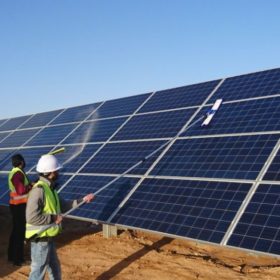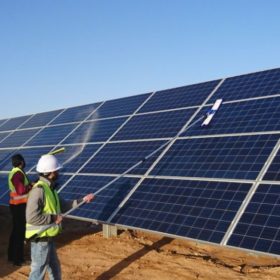Water scarcity and the growing need for smarter solutions in solar projects

The inefficiency and irregularity of cleaning the solar panels manually, and the associated use of water defeat the purpose of shifting to renewable energies.
India is a country that is developing rapidly and with this growth comes an increasing demand for water. Although India is well-endowed with strong natural river systems, water is a scarce resource in the country of 1.3 billion people and growing.
Water crisis is causing problems worldwide more so in the times of the coronavirus pandemic when frequently washing hands and maintaining cleanliness is one important precaution to keep the deadly virus at bay.
Ironically, water is not available, as per the needs, in a large part of the country not just for people but also for industries.
According to a report, 60% of the water used in the solar sector for panel cleaning is sourced from ground through borewells, while the remaining requirement is met through surface water sources such as rivers, canals and lakes.
According to SEIA, on an average, all solar power technologies use almost 20 gallons per megawatt hour of water for cleaning solar collection and reflection surfaces. Groundwater is preferred by the industry as it is almost free and is operationally expedient.
The report further states, “while it requires specific regulatory permissions, there are various reports of illegal extraction. If surface water is used, the procurement responsibility is generally outsourced to a local vendor who supplies water through tankers.”
AI to the rescue
Solar panels need to be cleaned regularly as soiling due to accumulation of dust, dirt, pollution, bird-droppings etc affects their performance. Cleaning them requires a large amount of water, which is a challenge as solar projects are usually located in dry areas.
Higher costs are observed in the dry states of Rajasthan and Gujarat as these are arid regions. The manual or traditional challenges in the solar projects, mainly the inefficiency and irregularity of cleaning the solar panels, and the use of water to clean them defeat the purpose of shifting to renewable energies.
Artificial intelligence (AI) based solutions come as a smarter and handy alternative for solar module cleaning. The main options include waterless cleaning robots for solar panels. These technologies are now technically and commercially proven. They can help not only in reducing water use but also in increasing the power generation output. They can also reduce the cost of cleaning, which primarily depends on the cost of water and labour.
Need of the hour
Clean water is a natural resource just like fossil fuels on which we cannot depend for a very long period of time. By the use of water the ecosystem of 100% green energy cannot be achieved. We need to adopt non-conventional tools and measures to make renewable energy more sustainable for the future.
As the issue of water scarcity and solar energy are linked, the right intervention by the government and leading industries can help create more opportunities for the growth and development of solar energy led industries in India, leading to a much required solar revolution in the country.


